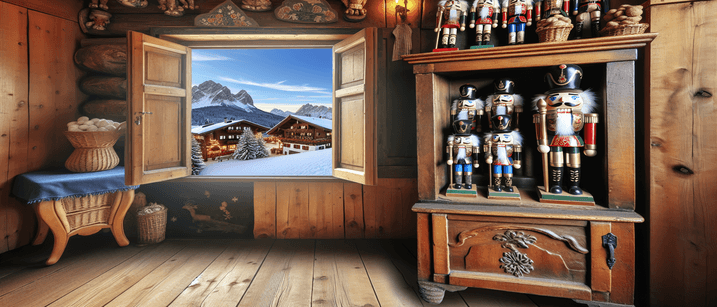The Origins of German Nutcrackers: From Forests to Festivities
It is fascinating how objects as simple as nutcrackers can carry centuries-old traditions. But where do these wooden figures originate? Why are they so essential to the German culture?
The genesis of German nutcrackers can be traced back to the 15th century in the rural parts of Germany. Villagers who primarily worked as woodworkers and toymakers in the mountainous forestry regions started crafting these functional tools. The nutcracker metamorphosed itself from a practical tool to a symbol of good luck and protective spirit, gradually becoming an integral part of traditional German Christmas celebrations.
“Just as the acorn befits a mighty tree, a simple nutcracker bore the seed of a rich heritage.”
This thoughtful maxim reflects the nutcracker’s humble beginnings and remarkable legacy, fostering an appreciation for a tradition borne from ordinary forms to extraordinary cultural symbolism. For more on this interesting transformation, visit nutcrackers that actually crack nuts.
The Icon Representation: Nutcrackers as Guardians of the Home
Have you ever thought about why these charming figures are often crafted in the image of kings, soldiers, and knights? The symbolism is more profound than you might think.
German folklore attributes a valuable role to nutcrackers as protectors against evil spirits and danger. The fierce expressions etched on their faces are not mere decoration but representative of their strength to ward off harm. In the hearth and heart of homes, they hold sentinel, providing both functional utility and spiritual safeguarding.
“In every folklore of Germany, Nutcrackers are the undefeated guards of hearth, guarding against goblins of misfortune.”
This testament illustrates the revered status of nutcrackers, imposing a narrative far beyond the aesthetic, suggesting protective presence despite their inanimate nature. Learn more about their cultural symbolism here.
Evolutions and Variations: Styles from Different German Regions
Though united in their symbolic significance, nutcrackers differ greatly in their crafting styles across Germany. Have you observed these subtle differences?
From the Ore Mountains (Erzgebirge) to the region of Sonneberg, local woodworkers added their regional touch in the crafting process. While some regions preferred minimalistic styles, others exhibited intricate details in their wooden creations. These differing styles speak volumes about the tangled web of tradition, regional identity, and individual craftsmanship.
“Same soil, different roots, it’s the diversity in design reflecting the regional identity.”
This quote perfectly captures the regional variations of nutcrackers, highlighting the deeply ingrained cultural diversity within a shared tradition. If you’re interested in exploring the craftsmanship behind another famous German woodcraft, check out the art of German woodcarving.
The Nutcracker in German Folklore and Literature
German nutcrackers have seamlessly woven themselves into folklore and literature, further exhibiting their cultural significance. One of the most famous instances can be seen in E.T.A. Hoffmann’s story, “Nutcracker and Mouse King”.
This influential German author gave life to these inanimate figures in his fantastical tale which tells the story of a nutcracker coming to life to fight off an evil seven-headed Mouse King. Hoffmann’s tale was later adapted into the world-famous ballet, “The Nutcracker Suite”, by Peter Ilyich Tchaikovsky, reaching millions more through the language of dance and music.
“Each step of the Nutcracker ballet imbibes the quintessence of German folklore, from courage and adversity to magical heroism.”
This influence of this quote spreads its resonance beyond German borders, reinforcing the nutcracker’s emblematic status and the rich impact of German storytelling. Learn more about the origin and history of the nutcracker in this detailed account.
Beyond Christmas: The Modern Impact of German Nutcrackers Globally
German nutcrackers have transcended their domestic boundary, becoming synonymous with global celebrations of Christmas. From Germany to North America, these wooden figures have found their place at the center of the festive season, delighting children and adults alike.
They are seen as a staple Christmas decoration and collected as treasured souvenirs, representing a slice of German heritage worldwide. Empire State businesses like the “Steinbach Nutcrackers” and the “Christian Ulbricht GmbH & Co. KG” have played vital roles in promoting these charming artifacts globally.
“German nutcrackers are Christmas’ cultural ambassadors, encapsulating a slice of German heritage in every corner of the world.”
This quote accurately encapsulates the global journey of nutcrackers, depicting how these objects symbolize the spread of German culture to worldwide audiences. Today, nutcrackers not only recount a tale of German heritage but also bridge communities with shared festive revelry. Interested in German culture? Dive into famous German holidays and festivals here.
Recap Roundup
This article has taken you on an enlightening journey, tracing the origin, evolution, and widespread impact of German nutcrackers. Starting from their birth in the 15th-century woodshops to their present global recognition, nutcrackers carry an impressive legacy underscoring their strength, style, folktale inspirations, and global influence.
In this roundup, we encourage you to reflect upon each theme’s intertwined significance in understanding nutcrackers in their full essence. This journey is a testament to the power of cultural artifacts in preserving societal history while fostering a shared sense of joy and tradition. As Christmas approaches, let’s salute the ever-vigilant Nutcracker, a true emblem of German culture. For more fascinating reads, you can visit our blog.








